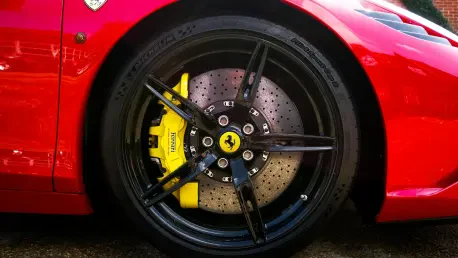As we dive into the intricate world of luxury automotive dynamics, I’m thrilled to sit down with Kwame Zaire, a renowned manufacturing expert with deep insights into electronics, equipment, and production management. With a keen focus on predictive maintenance, quality, and safety, Kwame offers a unique perspective on the challenges and strategies shaping the industry. Today, we’ll explore Ferrari’s recent decision to scale back car exports to the UK, delving into the interplay of tax policy shifts, supply chain impacts, and brand value preservation in a rapidly changing market.
Can you walk us through the reasons behind Ferrari’s decision to reduce car exports to the UK starting in 2025?
Certainly, Marie. Ferrari’s move to limit right-hand-drive deliveries to the UK from mid-2025 is largely a response to a shrinking demand from their core clientele—ultra-high-net-worth individuals. A significant driver of this is the UK government’s decision to end the non-domiciled tax status, which previously allowed wealthy residents to avoid taxes on overseas earnings. This policy shift has made the UK less attractive for these buyers, prompting Ferrari to reassess their market strategy to protect brand exclusivity and resale values.
How have changes in UK tax policies specifically influenced Ferrari’s customer base?
The scrapping of the non-dom tax regime has hit Ferrari’s customer base hard. Many of these high-net-worth individuals relied on this status to maintain their financial flexibility in the UK. With that gone, we’re seeing a notable exodus of these clients, either relocating to more tax-friendly regions or rethinking their investment in high-value assets like luxury cars. This directly impacts Ferrari’s sales projections in the region.
In what ways has the drop in demand from these wealthy buyers shaped Ferrari’s broader sales approach?
The reduced demand has forced Ferrari to pivot strategically. They’re not just cutting back on deliveries to the UK; they’re also tightening their global allocation model to maintain scarcity—a key pillar of their brand value. This means longer waiting lists and a more selective approach to who gets a car, ensuring that demand always outstrips supply, even in a shrinking market like the UK.
There’s talk of clients leaving the UK due to these tax changes. Can you share more about this trend and where they might be heading?
Absolutely. While exact numbers are hard to pin down, there’s a clear trend of ultra-wealthy individuals relocating from the UK to avoid the new tax burdens. Places like Monaco, Switzerland, and certain Middle Eastern countries are becoming popular destinations due to their favorable tax environments. Ferrari’s leadership has acknowledged this migration, and it’s a key factor in their decision to scale back in the UK market.
Shifting gears, how does reducing production of right-hand-drive models affect Ferrari’s manufacturing processes?
Producing right-hand-drive (RHD) vehicles for markets like the UK is already a niche operation, and cutting back further complicates things. Smaller production runs mean higher costs per unit because you lose the efficiencies of scale. Ferrari has to carefully balance their manufacturing lines, ensuring they don’t overcommit resources to a segment with declining demand while still meeting the needs of other RHD markets.
What challenges arise when dealing with unsold RHD vehicles, given they can’t easily be sold in left-hand-drive markets?
That’s a significant hurdle. RHD cars are tailored for specific markets, so unsold inventory can’t just be redirected to, say, continental Europe or the US. Ferrari faces logistical challenges in either storing these vehicles or finding alternative smaller markets. Repurposing isn’t really an option, so it often comes down to tighter inventory control upfront to avoid overproduction in the first place.
Ferrari often talks about a ‘management of scarcity’ strategy. How does this play out in the context of the UK market reduction?
The ‘management of scarcity’ is all about controlling supply to maintain exclusivity and protect resale values. In the UK, reducing deliveries extends waiting lists and slows the flow of new cars into the market. This not only helps stabilize depreciation rates for models already in circulation but also reinforces Ferrari’s image as an unattainable luxury, even in a market facing economic headwinds.
What kind of ripple effects are you seeing in Ferrari’s UK supply chain due to fewer deliveries?
The impact is felt across the board. UK dealers are seeing reduced inventory, which affects their revenue and operations. Service centers and pre-delivery inspection chains are also handling fewer cars, and suppliers of RHD-specific components—like steering assemblies—are getting smaller orders. This disrupts economies of scale for everyone in the ecosystem, from logistics partners to port operations handling fewer shipments from Italy.
How do these changes influence Ferrari’s European logistics network as a whole?
Ferrari’s European logistics take a hit with fewer cars heading to the UK. Shipping smaller container loads from their Maranello base reduces transport efficiency, meaning logistics partners operate below optimal capacity. This also affects customs throughput and port activity in the UK, creating a cascading effect through the entire delivery pipeline from factory to customer.
Looking ahead, what is your forecast for the luxury automotive market in regions facing similar tax policy shifts?
I think we’re going to see more luxury brands like Ferrari adopting a cautious, scarcity-driven approach in markets where tax policies squeeze high-net-worth buyers. The focus will be on preserving brand equity over chasing volume, with tighter allocations and a shift toward regions with stable or favorable economic conditions. However, this also means brands will need to innovate in customer engagement and financing models to keep demand alive in challenging markets. We might see a rise in bespoke offerings or subscription-style ownership to offset traditional sales declines.









